UPDF 2.0 is an affordable, user-friendly AI-powered PDF editor that offers comprehensive features like editing, OCR, AI-driven interactions, and batch processing, making document management efficient and intuitive. Positioned as a superior alternative to Adobe Acrobat, it enables users to easily edit, annotate, translate, and summarize PDFs while supporting seamless multi-file handling and cloud access.
The video introduces UPDF 2.0, an advanced AI-powered PDF editor that offers a comprehensive suite of features for managing and editing PDF documents. It highlights the software’s standard capabilities such as editing, highlighting, annotating, and optical character recognition (OCR), which converts images or handwritten text into editable text. A standout feature is UPDF AI, which allows users to interact with their PDFs through AI-driven functions like summarizing, translating, explaining, chatting, and creating mind maps, all within a unified platform that supports multiple files simultaneously.
The presenter contrasts UPDF with Adobe Acrobat, emphasizing UPDF’s affordability and user-friendly interface. Unlike Adobe, which is described as expensive and complicated, UPDF offers a straightforward installation process and an intuitive experience for editing and managing PDFs. Features such as page organization, commenting, form filling, and redaction are demonstrated, showcasing how users can easily redact sensitive information or add signatures and annotations across devices, with cloud storage options for seamless access.
OCR functionality is showcased by converting a picture of a document into an editable PDF, enabling users to copy, edit, and interact with the text. This integration with AI means that once the text is extracted, users can leverage UPDF AI to chat with the document, ask questions, translate content, and get summaries or explanations. The AI interaction is presented as a powerful tool for understanding complex documents like contracts, providing clear answers to specific queries, which significantly simplifies document review processes.
UPDF 2.0 also introduces batch processing capabilities, allowing users to perform actions like converting multiple PDFs into various formats (Excel, CSV, HTML, etc.), watermarking several documents at once, merging, compressing, and applying OCR in bulk. These features are designed to save time and improve workflow efficiency, especially for users who handle large volumes of documents. The batch watermarking tool, for example, lets users customize watermark text, size, and layout across multiple files simultaneously.
Finally, the video promotes UPDF 2.0 as a cost-effective alternative to other PDF editors, with a lifetime purchase option that includes free upgrades to future versions. The presenter encourages viewers to visit the official website to download the software and take advantage of the ongoing updates and AI enhancements. Overall, UPDF 2.0 is positioned as a holistic, versatile, and user-friendly platform that surpasses traditional PDF tools, especially for those seeking integrated AI functionalities.
